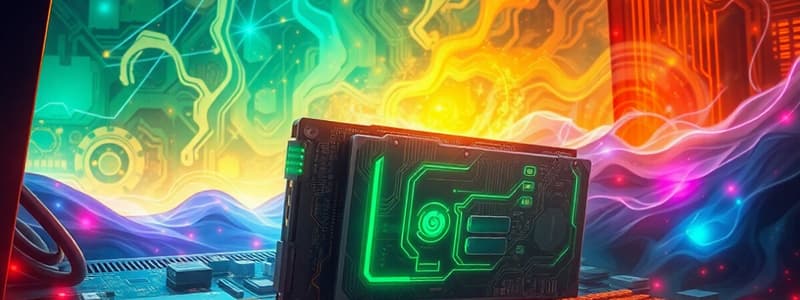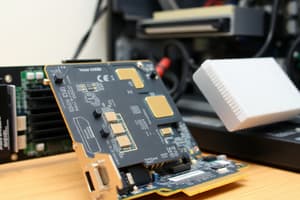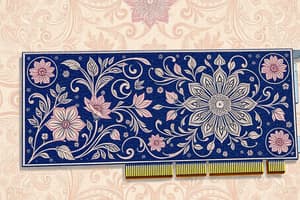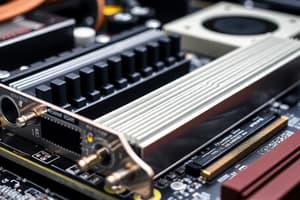Podcast
Questions and Answers
What is the main purpose of a TV tuner card in a computer?
What is the main purpose of a TV tuner card in a computer?
- To enable the reception of television signals (correct)
- To connect external storage devices
- To enhance audio fidelity
- To increase USB port availability
Which of the following describes the functionality of a RAID controller?
Which of the following describes the functionality of a RAID controller?
- Adds support for older storage interfaces like IDE
- Increases the number of USB ports available
- Combines multiple drives into a single logical unit for improved speed and redundancy (correct)
- Enables recording of video streams from gaming consoles
What type of card would you use to increase the number of available USB ports on a computer?
What type of card would you use to increase the number of available USB ports on a computer?
- Thunderbolt expansion card
- Capture card
- Storage expansion card
- USB expansion card (correct)
What is a key feature of PCIe compared to older bus systems?
What is a key feature of PCIe compared to older bus systems?
Which expansion card would be preferred for adding high-speed NVMe SSDs to a system?
Which expansion card would be preferred for adding high-speed NVMe SSDs to a system?
What is a key advantage of Thunderbolt 4 over Thunderbolt 3?
What is a key advantage of Thunderbolt 4 over Thunderbolt 3?
Which technology is commonly used for connecting external SSDs?
Which technology is commonly used for connecting external SSDs?
What is the primary role of a Network Interface Card (NIC)?
What is the primary role of a Network Interface Card (NIC)?
How does PCIe compare to older standards like PCI in terms of performance?
How does PCIe compare to older standards like PCI in terms of performance?
What is a significant feature of M.2 SSDs compared to SATA SSDs?
What is a significant feature of M.2 SSDs compared to SATA SSDs?
What is the main advantage of PCI Express (PCIe) compared to older expansion buses?
What is the main advantage of PCI Express (PCIe) compared to older expansion buses?
Which of the following USB versions supports the highest data transfer rate?
Which of the following USB versions supports the highest data transfer rate?
How do lanes in PCIe affect data transfer rates?
How do lanes in PCIe affect data transfer rates?
Which of the following applications commonly utilizes PCIe technology?
Which of the following applications commonly utilizes PCIe technology?
What is a notable feature of USB-C that distinguishes it from previous USB versions?
What is a notable feature of USB-C that distinguishes it from previous USB versions?
Flashcards are hidden until you start studying
Study Notes
Expansion Buses
- Expansion buses facilitate communication between CPU, memory, and peripherals (graphics cards, sound cards, network adapters).
- Modern buses offer faster data transfer, better power efficiency, and flexibility.
PCIe (PCI Express)
- Most widely used modern expansion bus.
- Point-to-point serial interface; dedicated connection for each device.
- Versions: PCIe 3.0 (8 GT/s), 4.0 (16 GT/s), 5.0 (32 GT/s), 6.0 (64 GT/s).
- Lanes: x1, x4, x8, x16, x32; more lanes = higher data transfer rates. GPUs often use x16.
- Applications: Graphics cards, network adapters, NVMe SSDs.
USB (Universal Serial Bus)
- Industry-standard bus for connecting peripherals (keyboards, mice, printers, storage devices, etc.).
- Evolved from slow to high-speed data transfer, power delivery, and display connections.
- Versions: USB 2.0 (480 Mbps), USB 3.x (up to 20 Gbps), USB4 (40 Gbps).
- Applications: Ubiquitous; data transfer and power delivery (USB-C Power Delivery up to 100W).
Thunderbolt
- Combines PCIe, DisplayPort, and power in one connection.
- Thunderbolt 3/4 use USB-C connector.
- Versions: Thunderbolt 3 (40 Gbps, daisy-chain up to six devices), Thunderbolt 4 (improved security, dual 4K display support).
- Applications: High-end laptops/desktops, fast external storage, eGPUs, high-resolution displays.
SATA (Serial ATA)
- Standard interface for connecting storage devices (HDDs and SSDs).
- SATA III (6 Gbps) is most common.
- eSATA: External version of SATA.
- Applications: Widely used in consumer-grade and large-scale storage; cost-effective.
M.2
- Physical form factor and expansion slot supporting PCIe and SATA.
- Used for SSDs and Wi-Fi/Bluetooth cards.
- PCIe-based M.2 SSDs (NVMe) are much faster than SATA counterparts (up to 7,000 MB/s in PCIe 4.0).
- Applications: Internal storage, laptops, high-performance desktops.
U.2
- Form factor for SSDs; used in enterprise environments.
- Supports PCIe.
- Higher power handling, capacity, and cooling than M.2.
- Applications: High-end workstations and enterprise servers.
PCI (Peripheral Component Interconnect)
- Largely replaced by PCIe.
- Parallel bus; shared bandwidth limited performance.
- Applications: Older devices (sound cards, network cards, storage controllers).
FireWire (IEEE 1394)
- High-speed expansion bus; used in digital video cameras, external hard drives, audio interfaces.
- Versions: FireWire 400 (400 Mbps), FireWire 800 (800 Mbps).
- Applications: Mostly obsolete; once popular in media production.
PC Expansion Cards
- Enhance computer functionality by adding features or improving performance.
- Plug into motherboard expansion slots.
Graphics Card (GPU)
- Improves image, video, and animation rendering.
- Offloads graphic-intensive tasks from the CPU.
- Common interface: PCIe.
Network Interface Card (NIC)
- Enables network connectivity (LAN or internet).
- Handles data communication via Ethernet or Wi-Fi.
- Common interfaces: PCIe (wired), PCIe/USB (wireless).
Sound Card
- Enhances audio capabilities.
- Converts digital audio to analog (and vice-versa).
- Common interface: PCIe (internal), USB (external).
Storage Expansion Card
- Expands storage; adds hard drives, SSDs, or RAID configurations.
- RAID controllers improve speed or provide redundancy.
- Common interfaces: PCIe, SATA, IDE.
USB Expansion Card
- Adds more USB ports.
- May offer newer USB standards.
- Common interface: PCIe.
Capture Card
- Records/streams video from external sources.
- Important for content creators.
- Common interfaces: PCIe (internal), USB/Thunderbolt (external).
TV Tuner Card
- Receives TV signals.
- Allows watching and recording live TV.
- Common interfaces: PCIe or USB.
Thunderbolt Expansion Card
- Adds Thunderbolt ports for high-speed data transfer.
- Connects to Thunderbolt devices (eGPUs, storage drives, monitors).
- Common interface: PCIe.
SATA Expansion Card
- Adds additional SATA ports for internal storage devices.
- Common interface: PCIe.
FireWire Card
- Adds FireWire ports for older devices.
- Common interface: PCIe.
PCIe (Peripheral Component Interconnect Express)
- High-speed, serial computer expansion bus.
- Replaces PCI, PCI-X, and AGP.
- High speed, multiple lanes (x1, x4, x8, x16), serial communication, versions (1.0-6.0).
- Backward and forward compatibility. Applications: GPUs, NVMe SSDs, network adapters, sound cards, etc. Scalable, power-efficient, Uses packet-based communication. Crucial for NVMe SSDs and high-bandwidth networking. PCIe 6.0 offers 64 GT/s per lane.
GPU (Graphics Processing Unit)
- Accelerates image, video, and animation rendering.
- Offloads graphical computations from the CPU.
- Handles various tasks beyond graphics rendering (AI computations, cryptocurrency mining).
GPU Function and Architecture
- GPUs excel at the complex mathematics of 3D-to-2D image transformation, including rasterization, texturing, shading, lighting, and anti-aliasing.
- Unlike CPUs, GPUs are optimized for parallel processing, enabling simultaneous calculations ideal for rendering numerous pixels and vertices.
GPU Components
- CUDA Cores/Stream Processors: The primary computational units (NVIDIA calls them CUDA cores, AMD calls them Stream Processors). More cores generally mean better performance.
- VRAM (Video RAM): Dedicated memory for storing graphical data like textures and models. Amount of VRAM significantly impacts performance; modern GPUs have 4GB to 24GB or more.
- Graphics Pipeline: Sequential stages converting 3D models into 2D images, comprising vertex processing, rasterization, pixel shading, and texture mapping.
- Cooling System: Essential for managing the significant heat generated by GPUs, often using heatsinks and fans or liquid cooling.
- Power Connectors: High-performance GPUs demand substantial power, typically requiring external 6-pin, 8-pin, or more power connectors.
GPU Types
- Integrated GPUs: Built into the CPU, power-efficient for basic tasks but lack power for demanding workloads.
- Dedicated/Discrete GPUs: Separate cards offering superior performance for gaming, video editing, 3D modeling, etc.
GPU Manufacturers and Architectures
- NVIDIA: Produces GeForce (gaming), Quadro (professional workstations), and Tesla (high-performance computing, AI) GPUs using the CUDA architecture.
- AMD: Offers Radeon (gaming, general consumers) and Radeon Pro/FirePro (professional workstations) GPUs using RDNA (gaming) and CDNA (high-performance computing) architectures.
- Intel: Recently entered the discrete GPU market with Intel Arc, targeting mid-range gaming and multimedia.
GPU Applications
- Gaming: Essential for rendering complex 3D environments with advanced effects like ray tracing and HDR.
- Video Editing and Production: Accelerates rendering, color correction, and effects processing.
- 3D Modeling and Animation: Provides faster rendering than CPU-based methods.
- Machine Learning and AI: Enables faster training of neural networks due to parallel processing capabilities.
- Cryptocurrency Mining: Used for solving cryptographic problems in certain algorithms.
- Scientific Research: Handles large datasets and complex calculations for simulations and modeling.
- Virtual Reality (VR) and Augmented Reality (AR): Critical for achieving necessary frame rates and visual quality.
GPU Technologies and Features
- Ray Tracing: Simulates realistic light interaction for improved visuals.
- DLSS (Deep Learning Super Sampling): AI-powered technology improving frame rates without sacrificing image quality (NVIDIA).
- CrossFire (AMD) and SLI (NVIDIA): Multi-GPU technologies (less common now).
- G-Sync (NVIDIA) and FreeSync (AMD): Adaptive sync technologies for smoother gaming experiences.
Cooling and Power
- Cooling: High-end GPUs require robust cooling (heatsinks, fans, liquid cooling).
- Power Consumption: High-performance GPUs need substantial power, often needing dedicated power connectors.
GPU Labeling
- Manufacturer: NVIDIA or AMD.
- Series: Indicates generation (e.g., RTX, GTX, RX).
- Model Number: Identifies performance tier within the series.
- Sub-Model/Variant: (e.g., Ti, XT, Super) signifies a performance boost.
- Memory Size: Specifies onboard VRAM (e.g., 8GB GDDR6).
- Special Features: Highlights supported technologies (e.g., DLSS, Ray Tracing).
NVIDIA Naming Convention
- Generational Indicator: First number(s) (e.g., "3" in 3070).
- Performance Ranking: Subsequent numbers (e.g., "070" in 3070).
- TI Suffix: Indicates a performance boost over the non-Ti model.
AMD Naming Convention
- Series Indicator: First number after the prefix (e.g., "7" in RX 7800).
- Performance Tier: Subsequent numbers (e.g., "800" in RX 7800).
- XT Suffix: Denotes a higher-performance version.
Studying That Suits You
Use AI to generate personalized quizzes and flashcards to suit your learning preferences.




